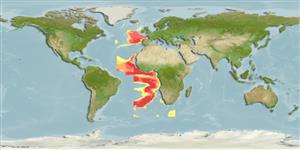Classification / Names
Nomi Comuni | Sinonimi | Catalog of Fishes(Genere, Specie) | ITIS | CoL | WoRMS | Cloffa
>
Stomiiformes (Lightfishes and dragonfishes) >
Stomiidae (Barbeled dragonfishes) > Melanostomiinae
Etymology: Eustomias: Greek, eu = good + Greek, stoma = mouth (Ref. 45335).
Environment: milieu / climate zone / depth range / distribution range
Ecologia
marino batipelagico; distribuzione batimetrica 592 - 657 m (Ref. 34246). Deep-water
Distribuzione
Stati | Aree FAO | Ecosystems | Presenze | Point map | Introduzioni | Faunafri
Atlantic Ocean: tropical mid-Atlantic.
Size / Peso / Age
Maturity: Lm ? range ? - ? cm
Max length : 11.5 cm SL maschio/sesso non determinato; (Ref. 34246)
Short description
Chiavi di identificazione | Morfologia | Morfometria
A single-branched barbel arising from the main stem. The branch has several side filaments and a lanceolate opaque body distally and not reaching or reaching beyond the barbel tip. The proximal part of the terminal bulb is pigmented dorsolaterally except for a mediodorsal unpigmented streak. The terminal filaments are tiny, simple, and not reaching beyond the bulb tip (Ref. 34246).
Life cycle and mating behavior
Maturities | Riproduzione | Spawnings | Egg(s) | Fecundities | Larve
Clarke, T.A., 1999. Pelagic fishes of the genus Eustomias (Melanostomiidae) similar to Eustomias dendriticus Regan and Trewavas with the description of seven new species. Copeia 1999(4):1002-1013. (Ref. 34246)
IUCN Red List Status (Ref. 130435)
Threat to humans
Harmless
Human uses
Strumenti
Special reports
Download XML
Fonti Internet
Estimates based on models
Preferred temperature (Ref.
123201): 1.8 - 2.6, mean 1.8 °C (based on 4 cells).
Phylogenetic diversity index (Ref.
82804): PD
50 = 0.5000 [Uniqueness, from 0.5 = low to 2.0 = high].
Bayesian length-weight: a=0.00302 (0.00117 - 0.00783), b=3.12 (2.89 - 3.35), in cm total length, based on LWR estimates for this (Sub)family-body shape (Ref.
93245).
Trophic level (Ref.
69278): 4.1 ±0.7 se; based on size and trophs of closest relatives
Resilienza (Ref.
120179): Alto, tempo minimo di raddoppiamento della popolazione meno di 15 mesi (Preliminary K or Fecundity.).
Fishing Vulnerability (Ref.
59153): Low vulnerability (10 of 100).
